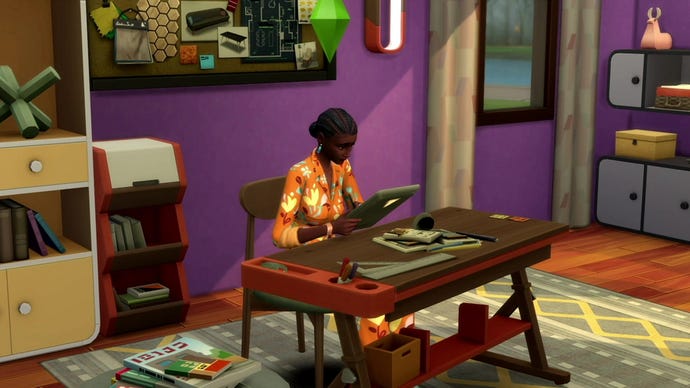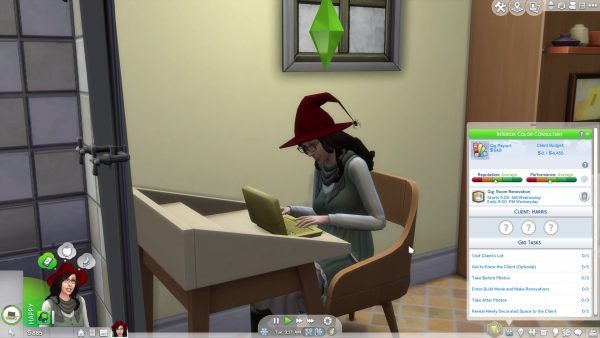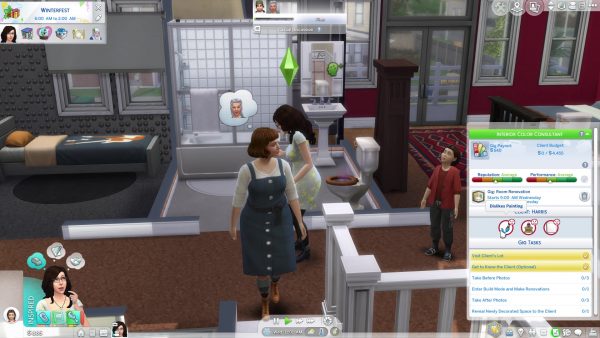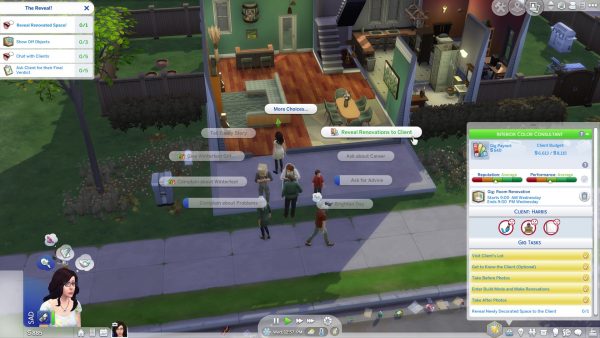The Sims 4 Interior Decorator career beginner’s guide | Professional reputation and client relationships explained
The Sims 4: Dream Home Decorator game pack introduces the Interior Decorator career. At last, Sims are able to take a more active role in shaping their homes — and since most Sims players have been casting themselves in the role of architect and interior designer for years, it's a way to bring both major gameplay styles together for the first time in this generation of the franchise.
- About the Interior Decorator career in The Sims 4
- How to get started in the Interior Decorator career in The Sims 4
- Your first day as an Interior Decorator in The Sims 4
- The Client
- Performance and Reputation
About the Interior Decorator career in The Sims 4
The Interior Decorator career is a profession, or active career, in The Sims 4 (like the careers added in the Get to Work and Get Famous expansions). This means that you have the option to accompany your Sims to their place of work and control their actions throughout the work day. It also means that there are no branching career paths: instead, all Interior Decorators advance through the same ten promotion levels.
If you also own Discover University, unfortunately Interior Decorator doesn't show up as a benefited career under any of the degrees yet. However, we've seen this happen before with new careers, so it'll probably be implemented in an upcoming patch. It's a safe bet it'll be either Art History (which combines the social and visual arts skills the career requires) or Fine Art (which tends to be used for the more practical artistic careers).
How to get started in the Interior Decorator career in The Sims 4
To join the Interior Decorator career, use your Sim's phone and go to Work > Find a Job > Professions (optional filter). Scroll down until you see the option for Interior Decorator, then click the tick button to accept the job.
However, this is where things get a little bit different. The Interior Decorator career functions somewhere halfway between a classic profession (like Doctor, Scientist, or Detective) and one of the freelance careers that have been added to The Sims 4 through various update patches and DLC over the years.
Instead of being assigned a work schedule, with days off and shift patterns decided for you, you need to seek out gigs for your Sim and manage their time without that structure. If you've already played Get Famous you'll be familiar with this style of gameplay, as it's shared with the Actor career.
On your Sim's career panel, there's a button in the top right corner with an icon of a clipboard inside it. Click on this to see the list of available gigs.
You can choose to filter this list for Room Renovations, Room Additions, Level Renovations, or Level Additions.
At first, you won't have very many gigs to pick from. However, you will be able to see greyed out options that are locked due to your current experience and reputation.
You'll also be able to see the client's name, the type of renovation they want, their budget, and the name of the renovation goal (i.e. "Fabulous Living Room Renovation"). You can hover over this last one to get a brief description of the job. There's also your Sim's eventual pay, their start date, and the deadline for completion.
Simply click on a gig in the panel to take it.
Your first day as an Interior Decorator in The Sims 4
Once you've accepted a gig, it will be added to your Career panel. Note that like all gigging careers in The Sims 4, you can only have one active gig at a time.
All gigs have a start time and a completion deadline. For Interior Decorators, all gigs last 12 in-game hours, starting at 9am and with a deadline of 9pm the same day. Unlike other active professions in The Sims 4, this is a hard deadline: you don't have the option to extend the timer even once.
Once you've accepted the gig, you can visit the Career tab again to view the Gig Tasks checklist. These are the tasks that you need to get done during the gig. However, you can't actually fulfil any of them until the gig begins — better to focus on getting your Sim's needs high so that they can go to work in the best mood possible.
Upon accepting your first gig, you'll also receive a new Memory Card object in your Sim's inventory. This is used to manage the before-and-after photos they'll be taking as part of their work as an Interior Decorator.
Like the other active professions (and the Paranormal Investigator freelance career), you'll be given a choice at the gig's start time: accompany your Sim to work, or send them alone. Doing the latter will result in your Sim going to an ordinary workday off-screen — they'll still gain experience and bring home the same pay, though I've observed it's impossible to get a promotion when sending a professional Sim to work alone.
Plus, clearly the whole point of the Interior Decorator career is player micro-management. Really the only reason not to accompany them is because you have another Sim in the same household who needs your attention.
When you arrive at the client's location, you can begin to work your way down the Gig Tasks list. The overall feel of these will be broadly familiar if you've played other active professions in The Sims before. A typical day in the life of an interior decorator involves taking before and after photos, chatting with the client, and performing the requested renovations in Build/Buy Mode.
(Incidentally, in case you were worried: entering Build/Buy Mode during the gig pauses Live Mode, just like it would in ordinary gameplay. So take as long as you need: you're not actually decorating against the clock.)
However, there's a social aspect to the Interior Decorator career that's entirely its own thing, and is worth going into in a bit more detail.
The Client
Below the gig details and above your task checklist is another section brand-new to the Interior Decorator career: the Client section.
To begin with, it shows a series of circles with question marks in them. In order to carry out the renovations for the gig to the highest quality, you should talk to the client to fill these circles with their Likes and Dislikes. (For the purposes of the Interior Decorator career, the client is any Sim who lives in the client household.)
Using the Get to Know interaction is a good way to build rapport, but you're better off using the career-specific interactions under the Interior Decorator social menu. The client will then tell you one of their likes or dislikes at random. You can also use the Friendly social menu to ask directly about their favourite colours, design styles, and hobbies if you want to know about one category specifically.
Once you've filled all the circles under the client section, you can keep asking questions, but what you learn will no longer be a metric for this particular gig. Including furnishings and items the client likes will significantly raise your score. Be sure to avoid their dislikes, though, or risk lowering your score for the gig.
Which brings us neatly to the other aspect of client management: the Reveal.
The Reveal is an interaction used by an Interior Decorator shows off their work to the client, reality show-style. Their reaction will be based not only on how well you matched their requirements, but will be strongly influenced by their Likes and Dislikes.
Choosing to do a Reveal will kick off a goaled event. There's no time-limit involved (except for the existing gig end-time of 9pm), so let everyone take their time having a good look around.
Completing the Reveal marks the end of the gig. As long as you complete your Gig Tasks on time, you'll likely see your Career Performance increase. However, don't dismiss a client's preferences, as these can impact on your Reputation.
Performance and Reputation
There's one career feature that's so far unique to Interior Decorators: a second progress bar.
For every other career in The Sims 4 (and indeed in most Sims games before it), you've had a Performance bar measuring your progress. High performance means a promotion is on the horizon, while poor performance might mean demotion or even outright firing if you don't take steps to improve it.
Interior Decorators are still measured on their performance, but they also have to manage their Reputation. This is completely separate from the social reputation system introduced in Get Famous, and relates solely to how well regarded they are as a professional.
Unlike Performance, Reputation doesn't reset after every promotion. In the long-term, a good reputation can help your Sim get repeated clients; more prestigious gigs — including opportunities to renovate businesses as well as private home lots; and even in-game brand deals.
Initially, a good Reputation is built in the same way as good performance: pay attention to the client's Likes and Dislikes, and avoid going over budget. After a few promotions, you can use social media to improve your professional reputation as well, and even write design books to provide a further boost.

















